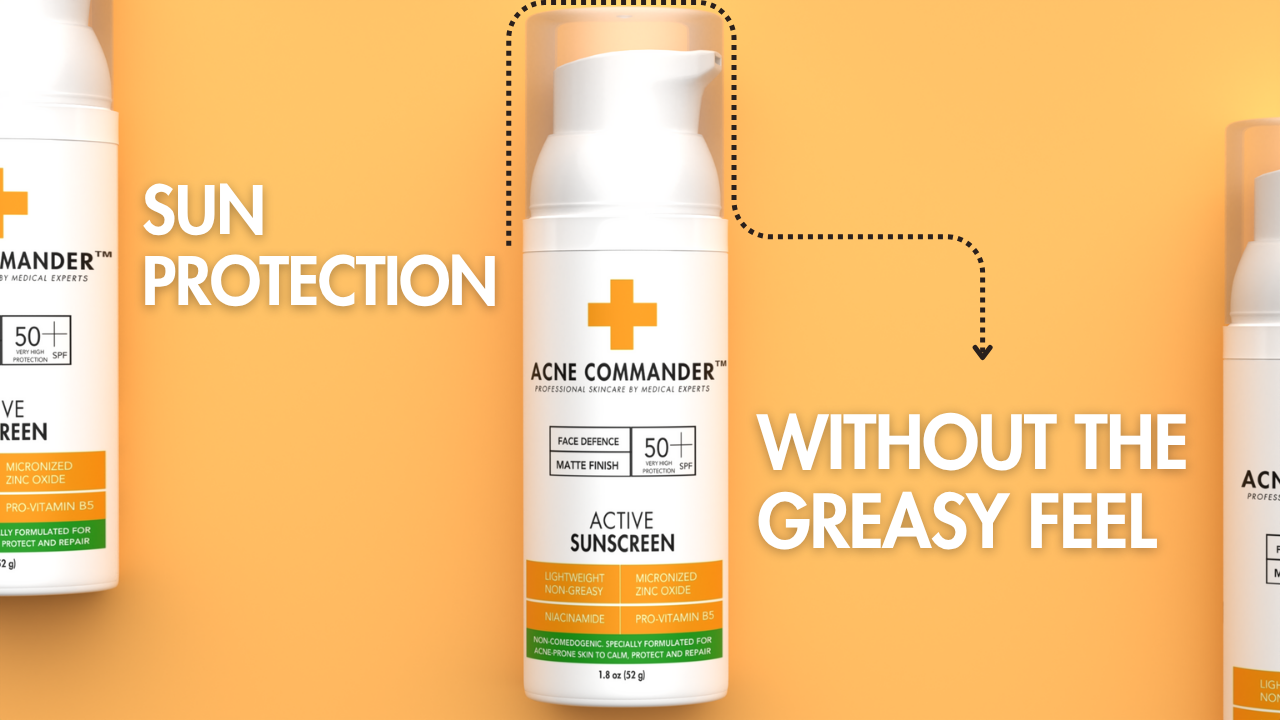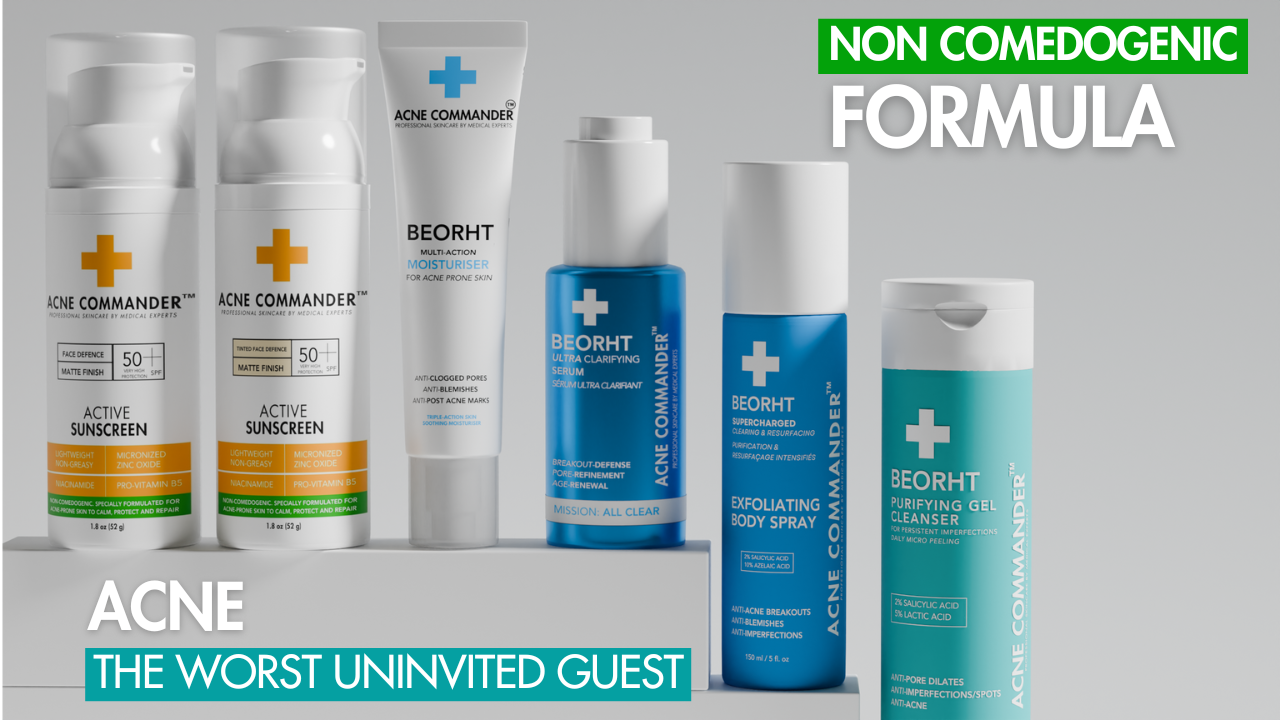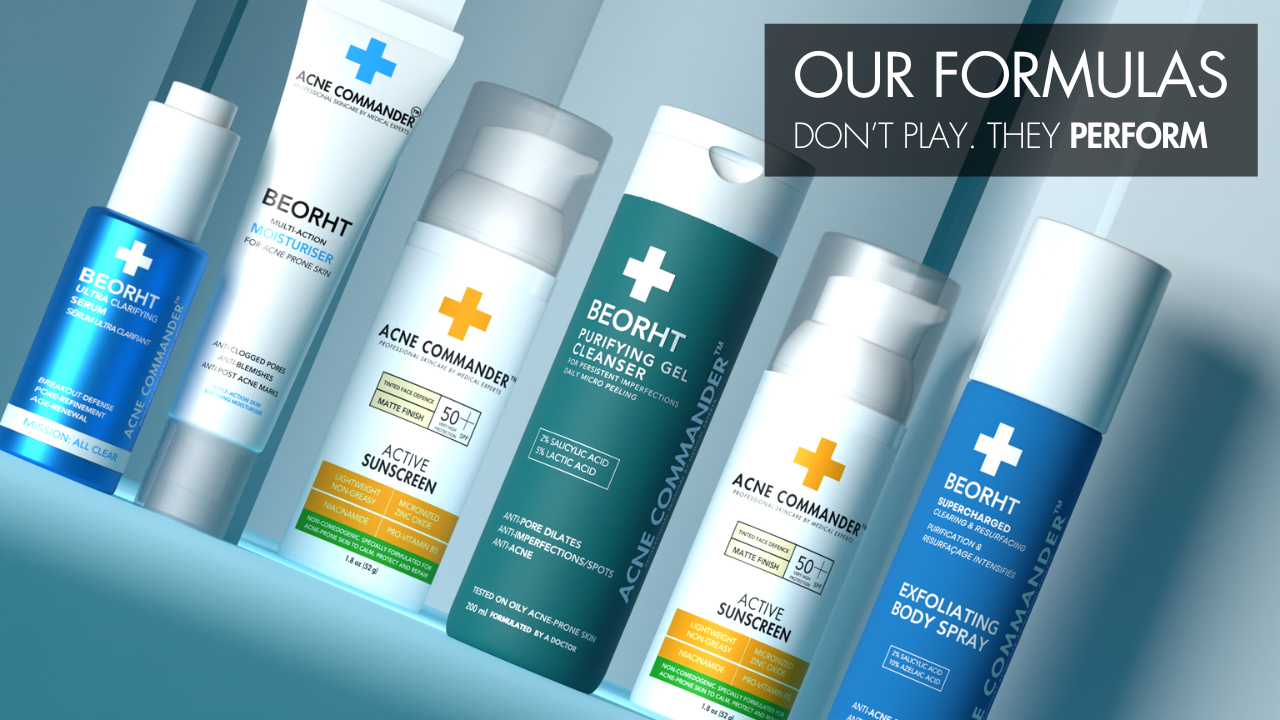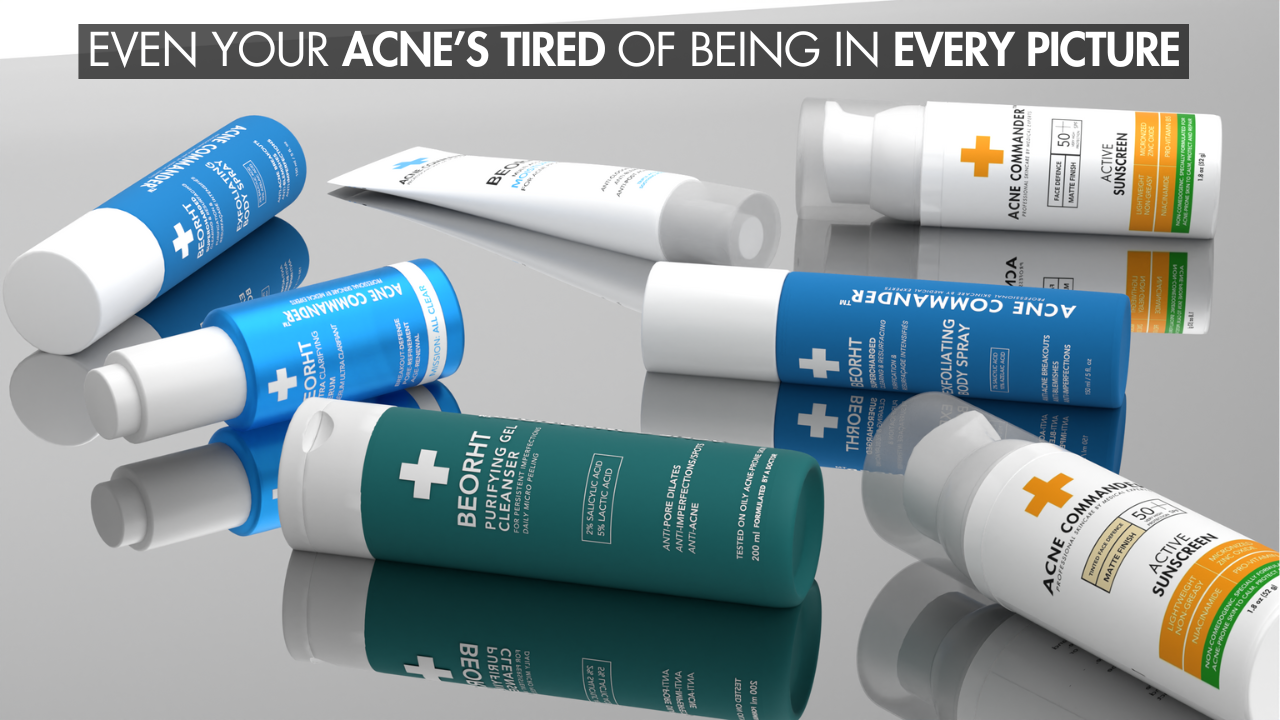Introduction: The Importance of Proper Sunscreen Removal for Acne-Prone Skin
We all know the importance of wearing sunscreen every day, especially when you have acne-prone skin. Sunscreen protects your skin from harmful UV rays and prevents sunburn, hyperpigmentation, and post-acne marks. However, one crucial step that many people overlook is properly cleansing sunscreen from their skin at the end of the day.
Leaving sunscreen on your skin, especially if it's non-comedogenic or contains heavy oils, can contribute to clogged pores, increased oil production, and ultimately, breakouts. In this article, we’ll guide you on how to properly remove sunscreen without irritating your skin or causing more acne. We’ll also explain why Acne Commander's Broad Spectrum SPF50+ Active Sunscreen is easy to cleanse off and gentle on acne-prone skin.
Why Proper Sunscreen Removal Is Essential for Acne-Prone Skin
If sunscreen is not removed properly, it can mix with dirt, oil, and sweat, leading to clogged pores. This can result in blackheads, whiteheads, or pimples, especially in areas where sunscreen was applied heavily, like the face and neck. For those with acne-prone skin, not cleansing sunscreen thoroughly can make existing acne worse and cause more flare-ups.
How to Remove Sunscreen from Acne-Prone Skin
Proper sunscreen removal is key to preventing breakouts and maintaining clear skin. Here’s a step-by-step guide to cleansing sunscreen from acne-prone skin:
Use a Gentle Cleanser
Start with a gentle cleanser that is formulated for acne-prone or sensitive skin. Avoid harsh soaps or cleansers with strong fragrances, as they can dry out your skin or cause irritation. A non-comedogenic cleanser will help break down sunscreen without causing clogging or irritation.
For effective sunscreen removal, look for a gentle, hydrating cleanser that can emulsify and remove both sunscreen and the buildup of oil from the day.
Double Cleanse if Necessary
If you’re using a physical sunscreen or a water-resistant chemical sunscreen, it’s a good idea to perform a double cleanse. This method involves using an oil-based cleanser followed by a water-based cleanser.
Oil-based cleansers break down the sunscreen and makeup without irritating the skin, while a second, gentle foaming or gel cleanser ensures that all residue is removed without stripping your skin’s natural moisture.
Use a Micellar Water or Sunscreen-Specific Cleanser
If you prefer a simpler routine, micellar water or an oil-free sunscreen-specific cleanser can be a great option. These products are designed to break down sunscreen effectively while being gentle on the skin. Micellar water is especially useful for quick and easy removal, as it lifts impurities and sunscreen from the skin without the need for rinsing.
Be Gentle and Avoid Scrubbing
When cleansing, be sure to use gentle circular motions. Scrubbing your skin too hard can cause irritation and inflammation, leading to more acne breakouts. Avoid using rough washcloths or scrubbing pads, as they can aggravate the skin, especially when it’s already inflamed due to acne.
Rinse Thoroughly with Lukewarm Water
After applying your cleanser, rinse your face with lukewarm water. Hot water can dry out the skin, while cold water won’t effectively remove all the residue. Lukewarm water is the perfect temperature to help cleanse without irritating your skin.
How to Cleanse Sunscreen Without Irritating Acne-Prone Skin
Removing sunscreen is important, but it's equally important to do it in a way that doesn't irritate or inflame acne-prone skin. Here are some tips for gentle cleansing:
Use a Non-Comedogenic Sunscreen
Choosing a non-comedogenic sunscreen, like Acne Commander's Broad Spectrum SPF50+ Active Sunscreen, is key. It is specifically formulated to prevent pore-clogging, which reduces the risk of acne flare-ups. Acne Commander's sunscreen is easy to cleanse off without irritating your skin, thanks to its lightweight, oil-free, and non-comedogenic formula.
Hydrate After Cleansing
After cleansing, always follow up with a moisturizer that is suited for acne-prone skin. Cleansing can sometimes strip the skin of natural oils, so using a hydrating moisturizer helps maintain the skin’s moisture balance and prevents the skin from becoming dry or irritated.
Why Acne Commander's Broad Spectrum SPF50+ Active Sunscreen Is Easy to Cleanse Off
Acne Commander's Broad Spectrum SPF50+ Active Sunscreen is designed for acne-prone skin, and it is easy to cleanse off at the end of the day. Here’s why:
-
Non-Comedogenic: The sunscreen is oil-free and won’t clog pores, making it safe for acne-prone and oily skin.
-
Soothing Ingredients: With Hyaluronic Acid and Niacinamide, this sunscreen hydrates and soothes irritated skin, reducing redness and inflammation caused by acne.
-
Broad-Spectrum Protection: Provides SPF50+ protection, ensuring you’re protected from UV rays, but also allowing for easy removal with gentle cleansing.
Explore detailed information for Acne Commander's Broad Spectrum SPF50+ Active Sunscreen. Click Here
FAQ’s
1. Why is it important to remove sunscreen from acne-prone skin?
Not removing sunscreen properly can lead to clogged pores, breakouts, and skin irritation.
2. Can I use makeup wipes to remove sunscreen?
Makeup wipes can help remove some sunscreen, but they may not be thorough enough. It’s best to use a gentle cleanser for proper removal.
3. Should I use a double cleanse for sunscreen removal?
Yes, a double cleanse with an oil-based cleanser followed by a gentle water-based cleanser is effective for removing sunscreen thoroughly.
4. What’s the best way to remove physical sunscreen from the skin?
Using an oil-based cleanser is the most effective way to break down and remove physical sunscreens like Zinc Oxide and Titanium Dioxide.
5. Is it safe to cleanse my skin after sunscreen application?
Yes, it’s important to cleanse your skin after wearing sunscreen to avoid buildup and prevent acne flare-ups.
6. Can I use any cleanser to remove sunscreen?
It’s best to use a non-comedogenic and gentle cleanser to avoid irritation. Harsh scrubs or strong cleansers can worsen acne.
7. What’s the best cleanser for acne-prone skin after sunscreen?
Choose a gentle, hydrating cleanser that is suitable for acne-prone skin and doesn’t strip the skin’s natural oils.
8. Can sunscreen clog pores?
Non-comedogenic sunscreens won’t clog pores, making them safe for acne-prone skin. Always choose oil-free, non-comedogenic sunscreens.
9. How often should I remove sunscreen from my skin?
Sunscreen should be removed at the end of each day to prevent pore clogging and breakouts.
10. Does Acne Commander's sunscreen leave residue that’s hard to remove?
No, Acne Commander's Broad Spectrum SPF50+ Active Sunscreen is formulated to be easily removed during cleansing without leaving a heavy residue.
Conclusion: The Importance of Proper Sunscreen Removal
Properly cleansing sunscreen from acne-prone skin is essential for preventing breakouts, clogged pores, and skin irritation. Using the right products, like Acne Commander's Broad Spectrum SPF50+ Active Sunscreen, ensures that your sunscreen protects without causing issues. Follow a gentle cleansing routine, and your skin will stay healthy, clear, and protected.






